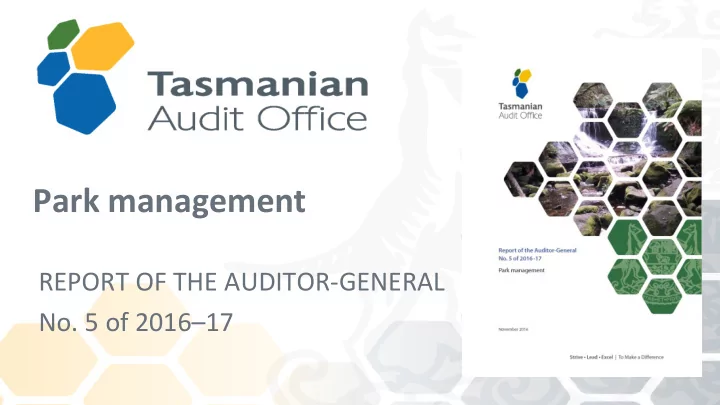

Park management REPORT OF THE AUDITOR-GENERAL No. 5 of 2016 – 17
Why this audit? • From our 2015‒16 Annual Plan of Work • No previous performance audit of park management • Tasmanians expect parks to be effectively managed and protected with increasing visitor numbers 1
Audit objective To form an opinion on how effectively Parks and Wildlife Service (PWS) manages the State’s national parks by reference to the adequacy of: • planning processes • plan implementation 2
Audit scope • Performance of the PWS over the period 2010 – 15 • Included National Parks, but largely excluded other parks and reserves • Chose a sample of eight National Parks for testing 3
Chapter 1: Logical allocation of funding and resources? We examined: • allocation of funding to National Parks • budget allocation by activity • the impact of the 2013 transfer of 315 600 hectares (ha) from Forestry Tasmania (FT) to PWS 4
Funding to national parks? • Priorities for big projects e.g. Three Capes Track • Regional business plans prioritised projects around safety, benefits to visitors and community • At field centres, staffing based on history, visitor numbers, internal complexity model Concluded: PWS had a logical process for funding and resourcing parks 5
Funding between activities? Regional business plans: Weeds and pest management Fire Other 0% management Roads, 1% 1% bridges, transport 25% Trackwork 37% Visitor services 36% 6
Funding between activities? • Fire management at 10% • Chart does not include: – Other PWS branches and Department of Primary Industries, Parks, Water and Environment (DPIPWE) units – Volunteer work Concluded: regionally there was little priority for pests, weeds and diseases 7
Additional FT reserves? In 2013, 315 600ha from 25 3.0 Tasmanian Forest 2.5 20 Hectares (million) $16.64 Intergovernmental $ per hectare 2.0 15 $13.52 $13.32 $12.37 $12.07 Agreement (TFIGA) and 1.5 $10.87 10 1.0 412 000ha as Future 5 0.5 Potential Production Forest 0 0.0 (FPPF) 2009-10 2010-11 2011-12 2012-13 2013-14 2014-15 Dollars per hectare Reserves under management 8
Additional FT reserves? • Legislative Council Committee recommended $10/ha to $16/ha • Other jurisdictions spend more (Aus average $26/ha) Concluded: 2014 – 15 appropriation per hectare continued to be low compared to other jurisdictions or funding of PWS in previous years 9
Chapter 2: Managing high-value assets? Were high-value assets: • formally identified? • protected by management processes? • subject to risk management? 10
High-value assets identified? Park management plans (PMPs): • Assessed park values • PWS sought stakeholder engagement • But PMPs outdated Concluded: identified high-value assets but PMPs outdated 1 1
Processes to protect high-value assets? PMPs and site plans strategies and actions outdated Other processes in place include • Zone systems • Reserve activity assessments (RAAs) • Environmental management system (EMS) Concluded: some relevant actions, but no systematic process for management of identified high-value assets 12
Risk management for high-value assets? Environmental Risk Management Policy (2007)in place: • PMPs and site plans analysed risk • Risk monitoring through RAAs and the EMS • No annual report for each park to support PMPs Concluded: no mechanism for routine monitoring of risks for high-value assets 13
Chapter 3: Effectively managing threats? Threats from: • Bushfires • Pests, weeds and diseases (PWDs) • Human impact Examined whether PWS had planned and implemented strategies 1 4
Effectively managing bushfires? • PWS had fire management plans, strategic, regional and local • Range of objectives and related strategies implemented • A bushfire risk assessment model had been implemented Concluded: PWS effectively managing bushfire threat 1 5
Effectively managing PWDs? • PMPs identifies threats, but dated • Strategies outlined in PMPs and Tasmanian Wilderness World Heritage Area (TWWHA) had a specific weed strategy. Few actions in business plans and only 8% of RAAs related to PWDs • EMS will improve monitoring Concluded: PWS docs out-of-date, few strategies or actions to control threats and no routine monitoring 16
Managing human impact? • PMPs identifies threats, but dated • Reserves Standards Framework established zones • RAA process assesses human impact • Strategies include visitor education and limits on numbers • Need for centralised risk register Concluded: no effective system for monitoring identified risks 17
Chapter 4: Managing Infrastructure and visitor safety? Examined whether PWS had: • defined objectives? • maintenance plans? • monitored risks? 18
Defined objectives? • Defined objectives for infrastructure, via PMPs, Reserve Standards Framework and business plans • E.g. encouraged visitors, services consistent with park values and development in zones Concluded: PWS had defined high-level objectives and safety requirements 19
Infrastructure maintenance plans? • Reserves Standards Framework set standards • 48% park assets maintained in 2014 – 15 • Asset Management System not fully implemented Concluded: frequently used infrastructure was effectively maintained but little evidence of structured program for walking and 4WD tracks 20
Monitoring infrastructure and visitor risk? • Visitor risk management policy included monitoring of assets • 323 condition inspections in 2015‒16 21
Monitoring infrastructure and visitor risk? 8.0 2.0 Incidents per 100000 visitors Average sverity rating 6.0 1.5 4.0 1.0 2.0 0.5 0.0 0.0 2010 2011 2012 2013 2014 2015 Incidents per 100 000 visitors Average Severity Rating Concluded: extensive inspection regime. Safety statistic of incidents per 100 000 had risen 22
Recommendations Ten recommendations including: • More emphasis on PWDs in regional business plans • PWS to review funding • Update and revise PMPs and use for monitoring high-value assets and threats, measurability of goals • Greater emphasis on PWDs • Implement EMS • Centralised risk register • Structured approach to infrastructure maintenance 23
Responses DPIPWE • emphasised other work for PWDs with partners but will review regional business plans • noted significant project funding in reference to infrastructure • is reviewing PMPs and measurability of objectives • some RAA risks not conducive to inclusion on a centralised risk register • supported recommendations 9 and 10 24
Any questions? 25
Recommend
More recommend